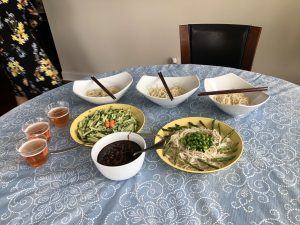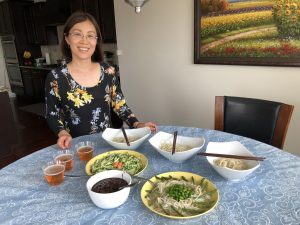Zoe Walker
Abstract
In the course of their migration around the world, noodles have been significantly influenced and changed by the culture around them. Starting with the background of noodles and their homelands in both Italy and China, this paper will discuss the forms of travel noodles have taken to expand throughout the world. I will explore the role of noodles on multiple different continents and talk specifically about different noodle dishes from different countries on those continents. Using each dish as a representation of the country, I will discuss the history and culture of those regions and its association with that noodle dish. The importance of this paper is to show how the rest of the world took noodles from two predominantly noodle countries, Italy and China, and incorporate their own styles to make these noodles a part of their own personal history. In summary, noodles are multicultural and universal, they are not limited to a specific region and have adapted and changed throughout history.
Food is culture. Food has influenced history, and in turn, historical events, customs, and traditions have influenced the food that is made and consumed. The ingredients used, the design of the dish, the flavors incorporated, and even the names of foods are all influenced by society and the culture surrounding it. One food that has been constantly growing, changing, and evolving over time is the noodle. Throughout this course, I have gained countless insights on the noodle and its journey throughout time, starting with the various theories of origin in either China or Italy 4,000 years ago. As we learned, a 4,000-year-old bowl of noodles was discovered in northwestern China providing evidence for the evolution of noodles beginning in China. There has also been the Marco Polo theory that Marco Polo traveled from to China from Italy and then returned to Italy with noodles which he introduced into the Italian culture. However, as the reading History of Pasta states, pasta was in Italy long before Marco Polo in forms such as lasagna mentioned as early as 1st century AD. Just as there are multiple theories that change and evolve, so do the noodles themselves throughout time. Classic Italian and Chinese noodle dishes have been created and perfected and over time they have become well established globally. With this expansion of noodles and noodle dishes around the world, various countries have created their own spins on pasta and noodle dishes that incorporate their past culture and history. Throughout this paper, I would like to delve into the spread of noodles around the globe and how countries have created their own noodle dishes to reflect their history and culture just as China and Italy have done.
Noodles have traveled the expanse of the globe in various forms. One form that is well known is through the Silk Road. The Silk Road was established during the Han dynasty and established trade between the East and West, mostly between European countries and Asian countries as travel across the seas was not well established. In 1453 the Silk Road closed but, in its place, came the travel of noodles across the seas during the Age of Discovery, Columbian Exchange, and Triangular Trade. This form of trade expanded noodles across the sea to the New World such as North and South America. Over the course of time, new noodle dishes have been established around the world due to the massive global trade routes that were created over the years. In various continents such as Asia, Europe, South America, and Africa, renditions of Italian and Chinese noodle dishes have manifested. Dishes such as ramen from Japan, pho from Vietnam, Kaesespaetzle from Germany, sopa seca from Mexico, boerewors pasta from South Africa and so many more.
Starting off in Asia, there are millions of noodle dishes that have been created from various countries in Asia full of culture and history. One of those countries is Japan with its famous noodle dish ramen. Ramen is considered the national dish of Japan and has grown in popularity worldwide. The dish consists of the noodles, broth, meat and vegetables. The noodles are made from wheat flour, salt, water, and baking soda which are simple ingredients similar to Italian and Chinese noodles. There are eighty-thousand ramen shops in the country of Japan and varying regions in Japan have different styles and variations of this dish. While this noodle can trace its roots to China, it migrated to Japan via Chinese immigrants in the 1880s where it gained its popularity and notoriety. Following the immigration of the Chinese noodle, in the 1910s ramen took on a Japanese spin with the inclusion of ingredients such as soy sauce, bamboo shoots and pork. This turned this dish into a hearty lunch food that was shared among Japanese workers. During the 1920s and 1930s ramen grew rapidly alongside the rapidly growing urban cities. This cheap, fast and nutritional dish fit perfectly within the confines of the modernizing and industrial lifestyle. However, following this boom in economy and ramen production came World War II. Shortages associated with war lowered the production of wheat noodles making it impossible for Japanese to enjoy ramen. By the end of the war in 1945, ramen dish consumption was extremely low. Over time the production of wheat noodles and other products increased as people returned to jobs in construction and heavy industry and the economy grew. As ramen culture continued to expand it began gaining attention globally. This reached its pinnacle in global popularity with the introduction and spread of instant ramen in the seventies. This invention created the fad that is instant ramen throughout the world. Since then ramen has become an international dish that is beloved around the world.
There are many cultural ties associated with ramen throughout Japan’s history. Over the years there have been different variations of ramen dependent on regions, food preferences, religion, etc. According to the article 10 Types of Ramen and Where They Are From, ramen from regions of Hokkaido such as Sapporo, with its hearty rich flavors, and Asahikawa, with its layer of oil to trap in the heat, are designed to fight the harsh winters of the region. While it has been signature for the ramen broth to be made with meat, the adaptation of vegetarian broth has also manifested due to cultural shifts. Tantanmen which is a broth that incorporates tastes made from black or white sesame has allowed for the creation of vegetarian ramen throughout Japan. There has also been the creation of halal ramen which has becoming increasingly prevalent in Japan and other countries of the world.
Another personal take on noodle dishes in Asia is pho noodles from Vietnam. Unlike the origination of Japanese ramen, the history of pho is not quite clear. There have been varying speculations of the origin story of Vietnamese pho. In the article Pho: The Vietnamese Addiction there are various theories such as it evolved from a Mongolian dish called Hot Pot. However, another theory suggests it came from Vietnamese nationalists living in the Chinese province of Yunnan. Here they learned to create local dishes such as a goat meat noodle soup which they took back to Vietnam and provided their own spin to it. Another theory speculates that pho was created to use up the leftover beef from the Vietnamese Tet (New Year’s) celebrations. While all of these origin stories claim to be the original, one theme is common: pho originated in Hanoi, northern Vietnam, and remained largely a northern Vietnamese dish for a long time. That is until 1954 when millions of Vietnamese fled south and settled in Saigon to escape the communist regime of the north. With this mass migration to the south came the spread of pho to the southern region. This also created a separation between Hanoi (north) and Saigon (south) pho noodles. The different styles of pho noodles created in these parts of Vietnam and smaller regions throughout the country have all been influenced by local cultural ideas and customs. There are northerners who believe the purest form of pho contains beef, fish sauce, lemon juice, chilis and sliced onions. There are southerners who enjoy the addition of sprouts, hot peppers, or chili black bean sauce. There have also been versions that substitute beef for chicken which is a lighter healthier taste. With all these regional variations of this beloved Vietnamese dish, there is still a standard requirement that must be met when making pho. The broth must be clear and void of any blood or fat indicating that the cook properly skinned and cleaned the bones. The proper bones must be used to create a harmonious broth that ties together all the ingredients and spices. There is also the importance of the freshness and quality of the ingredients. All ingredients, especially the meat, should be fresh not frozen to maintain all the rich flavors. In regard to the making of the noodles, they should be made from a paste of ground rice, alum and water then rolled flat and cut into thin noodle slices. If all of this is followed, you are sure to create an authentically delicious pho noodle dish. Throughout all these cooking criteria, the theme of fresh, handmade, local ingredients is integral to the making of pho noodles. This theme of using fresh and authentic ingredients can be seen throughout the course on Chinese and Italian noodles as well and it is clear to see that this idea and belief has spread through other countries along with the noodles themselves.
Moving into the continent of Europe, there are many countries and many cultures that have taken the noodle and created a dish with a sprinkle of their own personal history. As stated, the Silk road provided the means of transportation of goods between the East and the West. While it is believed that noodles weren’t brought to Italy via Marco Polo and the Silk road, this means of transportation still provided noodles with the access to spread into other European countries. In Germany the pasta dish Kaesespaetzle is an adaptation of the noodle which is similar to the American dish macaroni and cheese. Kaesespaetzle is made with spaetzle pasta which is beloved in Germany and is used to make many different pasta dishes. Spaetzle originated in the region of Swabia in Germany and is a staple in this region. Dating back to medieval times in 1725, spaetzle has been a big part of German culture and heritage. Various poems and songs were written about it as it was celebrated and loved by the people. In the article The History of Spaetzle the author mentions a poet Josef Eberle who called it “…The Foundation of our cuisine, … the glory of our country, …the alpha and omega of Swabian cuisine….”. Along with the culture and heritage of the pasta itself there is significance in the name spaetzle. It is speculated that the name comes from the German word spatzen which translates to little sparrow. The implications behind this name are widely speculated. Some believe the food got its name by how the people held the dough in their hand like it was a little sparrow to mold it and get its shape. Others believe that the dough was formed into 2 oval shapes resembling a sparrow’s body. Whichever theory is believed, it is clear that there is a lot of culture surrounding this German pasta.
Spaetzle is pieces of dough cooked in boiling water. The pasta is made from flour, egg, and water and the pieces are non-uniform. From this pasta comes a variety of dishes one of which is Kaesespaetzle. This dish is referred to as the German macaroni and cheese, but it has a denser pasta, regional cheese, and fried onions. As a result, this creamy dish has become a source of comfort food throughout the country. Homemade spaetzle is made using a spaetzle board and a scraper. It is then layered with shredded Emmenteler cheese and caramelized onions and baked in an oven.
Moving into the country of Spain, a pasta called cannelloni has moved from its origins in Italy and has become more popular and celebrated in the region of Catalonia, Spain. Cannelloni became popular in Catalonia in the 19th century and was renamed canelons in this region. In the past, when these dishes were gaining notoriety in Catalonia, they were filled with the leftover meat from celebrations on Christmas day including the one called the “one-pot meal tradition”. As a result, this dish is most commonly consumed on December 26th which is called Boxing Day or Saint Stephen’s Day. Due to the tradition of using the meat leftovers, canelons (Catalonia) have gained their distinction from cannelloni (Italy). In Catalonia they are stuffed with the cooked meat while in Italy they use minced meat mixed with tomatoes. The tradition of eating canelons on this day still exists; however, these pastas can also be filled with a variety of different ingredients such as meat, fish, vegetables or cheese. These stuffed pastas are then covered with béchamel sauce, which is said to also originate from Italy, and grated cheese. This Catalonian dish can also be paired with Spanish wine and nutmeg to tie the dish together.
Noodles are non-conforming and adapt depending on the region they are in. Through this dish you can see how these noodles travel and other countries apply their own culture and tradition to it. While the pasta is the same in both Italy and Spain and there are still commonalities, you can see how the region of Catalonia has created its own dish that breaks away from the Italian version. Starting with the name and ending with the drinks paired with it, these two adaptations of this pasta are different and indicative of the culture of that region.
In the continent of South America there are countless countries that have their own form of noodles. In Mexico there is the dish sopa seca de fideo which translates to dry noodle soup. According to the article Sopa Seca de Fideo, Mexican Noodles, this dish is very common in Central Mexico and the process of cooking this dish is similar to the making of Mexican red rice or sopa de arroz. The noodles used in this dish are typically very thin, fideo or vermicelli noodles, and are cut then cooked before being added to cook with the other ingredients. It is traditional to use chicken cooked in oil for the broth. Then ingredients such as garlic, onions, peppers, and ají panca are added to the broth with tomatoes. The noodles are added to the broth and the noodles absorb the flavors marinating in the liquid. This dish has been deemed a comfort food in Mexico, but it is believed to have originated in Spain. However, it can also be traced further back to Italy since the pastas for this dish originally came from Italy. This noodle then traveled to South America during the various trade routes that were established such as the Columbian Exchange. Mexico has made this dish its own by including ingredients that were native to the land before the Columbian exchange such as chili peppers. This shows that like the history of the canelons dish from Spain, while the pasta may have formerly come from Italy, as it has traveled the expanse of the globe and established roots in Mexico, new ingredients and flavors have been added to the dish to make it uniquely Mexican.
Traveling to the continent of Africa, there is the boerewors pasta from the country of South Africa. The headliner of this dish is boerewors which is a type of sausage that originated in South Africa and is an integral part of the South African cuisine. According to the article What is Boerewors? the name boerewors comes from the Afrikaans language and is broken down into “boer” (farmer) and “wors” (sausage). The sausage is traditionally made up of 90% meat such as beef, lamb, and pork and 10% spices such as coriander and black pepper. While it is a staple in South Africa, it is also common in other southern African countries such as Zimbabwe, Mozambique and Botswana. This sausage is thought to derive from a form of sausage that was made in southern France or the original recipes for this sausage came from South African migrants who brought them from the Netherlands. It is tradition to cook this sausage in a spiral shape during a “braai” meaning barbeque. Boerewors cooked over a braai is a part of the South African culture and is a strong patriotic tradition associated with national holidays. Moving into the pasta of this dish, various noodle shapes can be used such as penne or spaghetti, but it is common to use a tomato and basil sauce along with the grating of cheese on top. While it is clear the focal point of this dish is the boerewors, it is interesting to see how with the travel of noodles and Italian dishes to this region, you can take an Italian dish and add a South African twist by integrating the sausage that has so much cultural significance to this area. This shows the immersion of African culture in these European noodle dishes that have traveled over time due to colonization and expansion.
In summary, it can be seen that noodles are a multi-national food that have traveled the expanse of the globe and been picked up and modified by different countries. No country’s adaptation of the noodle is the same as the next and each country finds its own way to incorporate its’ history and culture into the various noodles that cross its borders. This is indicative of history and culture itself. While various countries have various beliefs, customs, and traditions, they can all find a connection with the noodle and incorporate it into their lifestyles. Along with that, the noodle is able to change and evolve from region to region. This can be seen in the different names given to the same noodle in different regions, the different ingredients used dependent on what’s more suitable for that area, and even the occasions in which they consume these dishes. From the very beginning 4,000 years ago, noodles have left a mark on history and will continue to for 4,000 years more.
Work Cited
Aditya. “Noodles and Pasta around the World: International Recipes to Discover.” InterNations Blog. N.p., 03 Jan. 2017. Web. 08 Aug. 2019.
Brickman, Sophie. “The History of the Ramen Noodle.” The New Yorker, The New Yorker, 20 June 2017. Web.
“Boerewors.” Wikipedia. Wikimedia Foundation, 12 July 2019. Web. 09 Aug. 2019.
Busetto, Arielle. “A Tale of the Changing Culture of Ramen.” Japan Forward. N.p., 27 May 2018. Web. 08 Aug. 2019.
“Canelons: Cultura Popular.” Canelons | Cultura Popular. N.p., n.d. Web. 09 Aug. 2019.
Demetri, Justin. “History of Pasta.” Life in Italy. N.p., 10 May 2018. Web. 08 Aug. 2019.
Ettenberg, Jodi. “A Brief History of Chili Peppers.” Legal Nomads. N.p., 12 May 2019. Web. 09 Aug. 2019.
Greeley, Alexandra. “Phở: The Vietnamese Addiction.” Gastronomica, vol. 2, no. 1, 2002, pp. 80–83. JSTOR, www.jstor.org/stable/10.1525/gfc.2002.2.1.80.
Herman, Alison. “The Messy History of Ramen.” First We Feast. First We Feast, 01 June 2018. Web. 08 Aug. 2019.
“The History of Spaetzle.” The Kitchen Project , The Complete Cooking Experience. N.p., 11 May 2018. Web. 09 Aug. 2019.
Killebrew, Kimberley. “Authentic Schwäbische Käsespätzle (German Cheese Spaetzle).” The Daring Gourmet. N.p., 23 Mar. 2019. Web. 09 Aug. 2019.
Mark, Joshua J. “Silk Road.” Ancient History Encyclopedia. Ancient History Encyclopedia, 06 Aug. 2019. Web. 08 Aug. 2019.
Mendel, Janet. “MY HOMAGE TO CATALONIA.” MY HOMAGE TO CATALONIA. N.p., 01 Jan. 1970. Web. 09 Aug. 2019.
Ozimek, Sarah. “Boerewors (South African Sausage) and a Taste of South African Safari • Curious Cuisiniere.” Curious Cuisiniere. N.p., 09 Jan. 2019. Web. 09 Aug. 2019.
“The Origin of Cannelloni – Borges – Mediterranean Cuisine.” Borges. N.p., n.d. Web. 09 Aug. 2019.
Roach, John. “4,000-Year-Old Noodles Found in China.” National Geographic. N.p., 12 Oct. 2005. Web. 08 Aug. 2019.
Solt, George. “The Untold History of Ramen.” Google Books. N.p., 2014. Web. 08 Aug. 2019.
“Sopa De Fideo.” Wikipedia. Wikimedia Foundation, 16 Dec. 2018. Web. 09 Aug. 2019.
Sur, Como. “Uncovering The Afro-Peruvian Influence: Carapulcra And Sopa Seca.” Como Sur | South American Gastronomy. N.p., 18 Mar. 2014. Web. 09 Aug. 2019.
“A Tale of the Changing Culture of Ramen.” Japan Forward. N.p., 28 May 2018. Web. 08 Aug. 2019.
Tan, Alethea. “10 Types Of Ramen and Where They Are From.” MICHELIN Guide. N.p., 02 Oct. 2017. Web. 08 Aug. 2019.
“What Is Boerewors?” Biltong St Marcus. N.p., 16 Jan. 2018. Web. 09 Aug. 2019.








